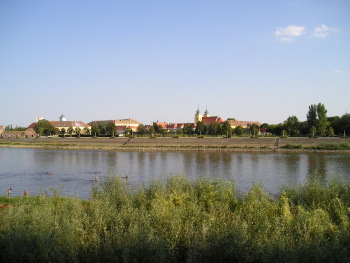Tvrda (Fort) in Osijek

Historical-Town Planning Ensemble Tvrda (Fort) in Osijek is part of the Tentative list of Croatia in order to qualify for inclusion in the World Heritage List.
The Tvrda (citadel) comprises a Habsburg star fort in which lies the Old Town of Osijek. It dates from the 18th century. The inner town was built in the spirit of Baroque town planning. Notable were its many inns, which geared to the soldiers and officers.
Map of Tvrda (Fort) in Osijek
Load mapThe coordinates shown for all tentative sites were produced as a community effort. They are not official and may change on inscription.
Community Reviews
Lisu Marian

From immemorial times, the Danube (the dust-free road) represented the border offered by nature somewhat difficult to cross.
The meanders that make up the current water border of Serbia from Croatia receive a major hydraulic inflow from Drava, another blue line that supports naval traffic, but not large ones.
It is precisely in this zone of merging the gentle waters of the Drave in the Danube that it is unsettled, it is the historical city of Osijec, a Neolithic preserve of various vestiges.
Rome installs its legion here, fixing with the colony the imperial borders now defended by the cohorts Alpinorum and Hispanorum - the name given to the settlement being Mursa. From the military fort it becomes a city, later a necropolis.
It is Hadrian's time, the one whose name I have found on the many historical objectives of the empire under different architectural forms - here being glorified the name for eternity by the name of the stone bridge.
When the Empire shows signs of fatigue, the Goths ravage the colony, it is the dark 4th century - and a little later, only at 441, the completion of the destruction operation is repeated to the Huns.
For its strategic position, much later, rises in the medieval period Baroque Fort - the exceptional natural location being completed with a fortification on the opposite bank where the offensive began, and behind the Water Gate a proud work, as large as it can not be. Affected by heavy squats is the mother fortress.
Between thick brick and stone walls, tightly plastered, it remained plentiful, as if the architect of the work wanted to copy the Dacian fortress model.
With all the defensive ability considered impenetrable, Osijek falls to the Ottomans.But this, on the other hand, made him add more beauty, by building mosques and Soliman's Bridge, the pride of 7 kilometers.
Austrian rule followed, since then heavy walls, but many of the specialized constructions with military role.
The interior of the fortifications offers a variety of attractions for those interested: churches, most of which, old and beautifully decorated, period houses with decorations on the frontispieces, metal doors and windows with security systems as if the personified devil himself feared.
In the center of the center is the Holy Trinity Square, the terminal being the monument that can hardly be included in the snapshots. The complex has a difficult name - Tvrdjda, which can be easily reached, on one side and the other being either museums, or places to spend but even buildings of the local university.
This is precisely the present importance of the city - the system conceived in the different eras, by each temporary ruler, detrimental to the time.
It is in fact the quintessence of evolution, but on a different scale.
The neo-gothic wonder, dedicated to Saints Peter and Paul, whose red tower tears the widow in the center of the present city, is 91 meters long and is thought to be exactly the height of the Osijek above sea level.
Read more from Lisu Marian here.
Site Info
- Full Name
- Historical-Town Planning Ensemble Tvrda (Fort) in Osijek
- Country
- Croatia
- Added
- 2005
- Type
- Cultural
- Categories
- Structure - Military and Fortifications Urban landscape - Post-medieval European
- Link
- By ID
Site History
2005 Added to Tentative List
Site Links
Visitors
24 Community Members have visited.